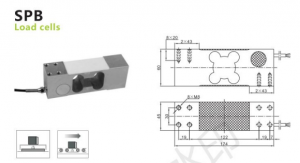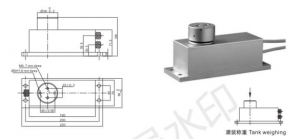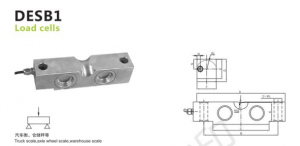A ଲୋଡ୍ ସେଲ୍ପ୍ରକୃତରେ ଏକ ଉପକରଣ ଯାହା ଏକ ଗଣ ସଙ୍କେତକୁ ଏକ ମାପଯୋଗ୍ୟ ବୈଦ୍ୟୁତିକ ଆଉଟପୁଟରେ ରୂପାନ୍ତରିତ କରେ। ବ୍ୟବହାର କରିବା ସମୟରେଲୋଡ୍ ସେଲ୍, ପ୍ରକୃତ କାର୍ଯ୍ୟ ପରିବେଶଲୋଡ୍ ସେଲ୍ ପ୍ରଥମେ ବିଚାର କରାଯିବା ଉଚିତ, ଯାହା ସଠିକ୍ ଚୟନ ପାଇଁ ଗୁରୁତ୍ୱପୂର୍ଣ୍ଣଲୋଡ୍ ସେଲ୍। ଏହା ସହିତ ଜଡିତ ଯେଲୋଡ୍ ସେଲ୍ ସ୍ୱାଭାବିକ ଭାବରେ କାମ କରିପାରିବ, ଏହାର ସୁରକ୍ଷା ଏବଂ ସେବା ଜୀବନ, ଏବଂ ସମଗ୍ର ଓଜନ ଯନ୍ତ୍ରର ନିର୍ଭରଯୋଗ୍ୟତା ଏବଂ ସୁରକ୍ଷା ମଧ୍ୟ।
ପରିବେଶର ପ୍ରଭାବଲୋଡ୍ ସେଲ୍ ମୁଖ୍ୟତଃ ନିମ୍ନଲିଖିତ ଦିଗଗୁଡ଼ିକୁ ଅନ୍ତର୍ଭୁକ୍ତ କରେ:
(୧) ଉଚ୍ଚ ତାପମାତ୍ରା ପରିବେଶ ଆବରଣ ସାମଗ୍ରୀ ତରଳିବା, ସୋଲଡର ସନ୍ଧିଗୁଡ଼ିକର ଖୋଲା ୱେଲ୍ଡିଂ ଏବଂ ଇଲାଷ୍ଟୋମରର ଆଭ୍ୟନ୍ତରୀଣ ଚାପରେ ଗଠନାତ୍ମକ ପରିବର୍ତ୍ତନ ଭଳି ସମସ୍ୟା ସୃଷ୍ଟି କରେ। ପାଇଁଲୋଡ୍ ସେଲ୍ଉଚ୍ଚ ତାପମାତ୍ରା ପରିବେଶରେ କାମ କରୁଛି, ଉଚ୍ଚ ତାପମାତ୍ରାଲୋଡ୍ ସେଲ୍ଗୁଡ଼ିକ ପ୍ରାୟତଃ ବ୍ୟବହୃତ ହୁଏ; ଏହା ସହିତ, ତାପ ଇନସୁଲେସନ, ଜଳ ଶୀତଳକରଣ କିମ୍ବା ବାୟୁ ଶୀତଳକରଣ ଭଳି ଉପକରଣଗୁଡ଼ିକୁ ଯୋଡାଯିବା ଆବଶ୍ୟକ।
(୨) ଧୂଳି ଏବଂ ଆର୍ଦ୍ରତାର ପ୍ରଭାବ ସର୍ଟ ସର୍କିଟରେଲୋଡ୍ ସେଲ୍। ଏହି ପାରିପାର୍ଶ୍ୱିକ ଅବସ୍ଥାରେ, ଏକଲୋଡ୍ ସେଲ୍ ଉଚ୍ଚ ସହିତବାୟୁ-ନିଷ୍ଠୁରତା ଚୟନ କରାଯିବା ଉଚିତ। ଭିନ୍ନଲୋଡ୍ ସେଲ୍ସେମାନଙ୍କର ବିଭିନ୍ନ ସିଲିଂ ପଦ୍ଧତି ଅଛି, ଏବଂ ସେମାନଙ୍କରବାୟୁ-ନିଷ୍ଠୁରତା ବହୁତ ଭିନ୍ନ।
ସାଧାରଣ ସିଲ୍ଗୁଡ଼ିକରେ ସିଲେଣ୍ଟ ଫିଲିଂ କିମ୍ବା ଆବରଣ ଅନ୍ତର୍ଭୁକ୍ତ; ରବର ପ୍ୟାଡ୍ଗୁଡ଼ିକୁ ଯାନ୍ତ୍ରିକ ଭାବରେ ଲଗାଯାଇଥାଏ ଏବଂ ସିଲ୍ କରାଯାଇଥାଏ; ୱେଲ୍ଡିଂ (ଆର୍ଗନ୍ ଆର୍କ ୱେଲ୍ଡିଂ, ପ୍ଲାଜମା ବିମ୍ ୱେଲ୍ଡିଂ) ଏବଂ ଭାକ୍ୟୁମ୍ ନାଇଟ୍ରୋଜେନ୍ ଫିଲିଂ ସିଲ୍।
ସିଲିଂ ପ୍ରଭାବ ଦୃଷ୍ଟିକୋଣରୁ, ୱେଲ୍ଡିଂ ସିଲିଂ ସର୍ବୋତ୍ତମ, ଏବଂ ଫିଲିଂ ଏବଂ ଆବରଣ ସିଲିଂ ସବୁଠାରୁ ଖରାପ। ପାଇଁଲୋଡ୍ ସେଲ୍ଯାହା ଏକ ସଫା ଏବଂ ଶୁଷ୍କ ଘର ଭିତରେ କାମ କରେ, ଆପଣ ଏକ ଗ୍ଲୁ-ସିଲ୍ ବାଛିପାରିବେଲୋଡ୍ ସେଲ୍, ଏବଂ କିଛିଙ୍କ ପାଇଁଲୋଡ୍ ସେଲ୍ଯେଉଁଗୁଡ଼ିକ ଆର୍ଦ୍ର ଏବଂ ଧୂଳିମୟ ପରିବେଶରେ କାମ କରେ, ଆପଣ ଏକ ଡାୟାଫ୍ରାମ ଗରମ ସିଲ୍ କିମ୍ବା ଡାୟାଫ୍ରାମ ୱେଲ୍ଡିଂ ସିଲ୍ ବାଛିବା ଉଚିତ, ପମ୍ପିଂ ଭ୍ୟାକ୍ୟୁମ୍ ନାଇଟ୍ରୋଜେନ୍ଲୋଡ୍ ସେଲ୍.
(୩) ଆର୍ଦ୍ରତା ଏବଂ ଏସିଡିଟି ଭଳି ଏକ ଅତ୍ୟନ୍ତ କ୍ଷୟକାରୀ ପରିବେଶରେ, ଯାହା ଇଲାଷ୍ଟୋମରକୁ କ୍ଷତି ପହଞ୍ଚାଇବ କିମ୍ବା ଏକ ସର୍ଟ ସର୍କିଟ୍ ସୃଷ୍ଟି କରିବ, ବାହ୍ୟ ପୃଷ୍ଠକୁ ଅଧିକ ସ୍ପ୍ରେ କରାଯିବା ଉଚିତ କିମ୍ବାଆଚ୍ଛାଦିତଷ୍ଟେନଲେସ୍ ଷ୍ଟିଲ୍, ଯାହାର ଭଲ କ୍ଷୋଭ ପ୍ରତିରୋଧକତା ଏବଂ ଭଲବାୟୁ-ନିରୋଧ.
(୪) ବିଦ୍ୟୁତ୍-ଚୁମ୍ବକୀୟ କ୍ଷେତ୍ରର ପ୍ରଭାବloaଡି ସେଲ୍ ଆଉଟପୁଟ୍ ଡିସଅର୍ଡର ସିଗନାଲ। ଏହି କ୍ଷେତ୍ରରେ, ର ସୁରକ୍ଷାloaଡି ସେଲ୍ ଏହାର ଭଲ ବିଦ୍ୟୁତ୍-ଚୁମ୍ବକୀୟ ପ୍ରତିରୋଧ ଅଛି କି ନାହିଁ ତାହା କଡ଼ାକଡ଼ି ଯାଞ୍ଚ କରାଯିବା ଉଚିତ।
(୫) ଜ୍ୱଳନଶୀଳ ଏବଂ ବିସ୍ଫୋରକ କେବଳ ସମ୍ପୂର୍ଣ୍ଣ କ୍ଷତି କରେ ନାହିଁଲୋଡ୍ ସେଲ୍, କିନ୍ତୁ ଅନ୍ୟ ଉପକରଣ ଏବଂ ବ୍ୟକ୍ତିଗତ ସୁରକ୍ଷା ପାଇଁ ମଧ୍ୟ ଏକ ବଡ଼ ବିପଦ ସୃଷ୍ଟି କରେ। ତେଣୁ,ଲୋଡ୍ ସେଲ୍ଜ୍ୱଳନଶୀଳ ଏବଂ ବିସ୍ଫୋରଣକାରୀ ପରିବେଶରେ କାମ କରୁଥିବା ବ୍ୟକ୍ତିମାନେ ବିସ୍ଫୋରଣ-ପ୍ରମାଣ କାର୍ଯ୍ୟଦକ୍ଷତା ପାଇଁ ଉଚ୍ଚ ଆବଶ୍ୟକତା ଉପସ୍ଥାପନ କରନ୍ତି: ବିସ୍ଫୋରଣ-ପ୍ରମାଣଲୋଡ୍ ସେଲ୍ଜ୍ୱଳନଶୀଳ ଏବଂ ବିସ୍ଫୋରକ ପରିବେଶରେ ଚୟନ କରାଯିବା ଆବଶ୍ୟକ। ଏହାର ସିଲିଂ କଭରଲୋଡ୍ ସେଲ୍ କେବଳ ଏହାକୁ ବିଚାର କରିବା ଉଚିତ ନୁହେଁବାୟୁ-ନିରୋଧ, କିନ୍ତୁ ବିସ୍ଫୋରଣ-ପ୍ରମାଣ ଶକ୍ତି, ଏବଂ କେବୁଲ୍ ଲିଡ୍ଗୁଡ଼ିକର ଜଳପ୍ରତିରୋଧକ, ଆର୍ଦ୍ରତା-ପ୍ରମାଣକ ଏବଂ ବିସ୍ଫୋରଣ-ପ୍ରମାଣକ ଗୁଣଗୁଡ଼ିକୁ ମଧ୍ୟ ବିଚାର କରାଯିବା ଉଚିତ।
ଦ୍ୱିତୀୟତଃ, ସଂଖ୍ୟା ଏବଂ ପରିସରର ଚୟନଲୋଡ୍ ସେଲ୍s.
ସଂଖ୍ୟାର ଚୟନଲୋଡ୍ ସେଲ୍s ଇଲେକ୍ଟ୍ରୋନିକ୍ ଓଜନ ଉପକରଣର ଉଦ୍ଦେଶ୍ୟ ଏବଂ ସ୍କେଲ୍ ବଡିକୁ ସମର୍ଥନ କରିବାକୁ ଆବଶ୍ୟକ କରୁଥିବା ବିନ୍ଦୁ ସଂଖ୍ୟା ଅନୁସାରେ ନିର୍ଣ୍ଣୟ କରାଯାଏ (ସ୍କେଲ୍ ବଡିର ଜ୍ୟାମିତିକ ଗୁରୁତ୍ୱାକର୍ଷଣ କେନ୍ଦ୍ରକୁ ପ୍ରକୃତ ଗୁରୁତ୍ୱାକର୍ଷଣ କେନ୍ଦ୍ର ସହିତ ମେଳ ଖାଉଥିବା ନୀତି ଅନୁସାରେ ସହାୟକ ବିନ୍ଦୁ ସଂଖ୍ୟା ନିର୍ଣ୍ଣୟ କରାଯିବା ଉଚିତ)। ସାଧାରଣତଃ, ଅନେକଲୋଡ୍ ସେଲ୍s ଅନେକ ସହାୟକ ବିନ୍ଦୁ ସହିତ ସ୍କେଲ୍ ବଡି ପାଇଁ ବ୍ୟବହୃତ ହୁଏ। ତଥାପି, କିଛି ବିଶେଷ ସ୍କେଲ୍ ବଡି ଯେପରିକି ଇଲେକ୍ଟ୍ରୋନିକ୍ ହୁକ୍ ସ୍କେଲ୍ ପାଇଁ, କେବଳ ଗୋଟିଏଲୋଡ୍ ସେଲ୍ ବ୍ୟବହାର କରାଯାଇପାରିବ। କିଛି ପାଇଁବିଦ୍ୟୁତ୍-ଚୁମ୍ବକୀୟ ଭାବରେ ମିଳିତ ତରାଜୁ, ଚୟନଲୋଡ୍ ସେଲ୍ ପ୍ରକୃତ ପରିସ୍ଥିତି ଅନୁସାରେ ନିର୍ଣ୍ଣୟ କରାଯିବା ଉଚିତ। ସଂଖ୍ୟା।
ଚୟନଲୋଡ୍ ସେଲ୍ ପରିସରକୁ ସ୍କେଲର ସର୍ବାଧିକ ଓଜନ ମୂଲ୍ୟ, ଚୟନିତ ସଂଖ୍ୟା ଭଳି କାରଣଗୁଡ଼ିକର ବ୍ୟାପକ ମୂଲ୍ୟାଙ୍କନ ଅନୁସାରେ ନିର୍ଣ୍ଣୟ କରାଯାଇପାରିବଲୋଡ୍ ସେଲ୍s, ସ୍କେଲ୍ ବଡିର ସ୍ୱୟଂ-ଓଜନ, ସମ୍ଭାବ୍ୟ ସର୍ବାଧିକ ଏକକ ଭାର ଏବଂ ଗତିଶୀଳ ଭାର। ସାଧାରଣତଃ, ପରିସର ସେତେ ନିକଟତର ହେବଲୋଡ୍ ସେଲ୍ ପ୍ରତ୍ୟେକକୁ ଦିଆଯାଇଥିବା ଭାର ସହିତଲୋଡ୍ ସେଲ୍, ଏହାର ଓଜନ ସେତେ ସଠିକ ହେବ। ତଥାପି, ପ୍ରକୃତ ବ୍ୟବହାରରେ, ଯେହେତୁ ଭାର ଉପରେ ପ୍ରୟୋଗ ହୋଇଥିଲାଲୋଡ୍ ସେଲ୍ ଓଜନ ହେବାକୁ ଥିବା ବସ୍ତୁ ସହିତ ସ୍କେଲର ସ୍ୱୟଂ-ଓଜନ, ଟାୟାର ଓଜନ, ଏକକ ଭାର ଏବଂ କମ୍ପନ ପ୍ରଭାବ ଅନ୍ତର୍ଭୁକ୍ତ, ଚୟନ କରିବା ସମୟରେ ଅନେକ କାରଣ ବିଚାର କରାଯିବା ଉଚିତଲୋଡ୍ ସେଲ୍ ନିଶ୍ଚିତ କରିବା ପାଇଁ ପରିସରଲୋଡ୍ ସେଲ୍ ସୁରକ୍ଷା ଏବଂ ଦୀର୍ଘାୟୁ।
ର ଗଣନା ସୂତ୍ରଲୋଡ୍ ସେଲ୍ ସ୍କେଲ୍ ବଡିକୁ ପ୍ରଭାବିତ କରୁଥିବା ବିଭିନ୍ନ କାରଣଗୁଡ଼ିକୁ ସମ୍ପୂର୍ଣ୍ଣ ଭାବରେ ବିଚାର କରିବା ପରେ ବହୁ ସଂଖ୍ୟକ ପରୀକ୍ଷଣ ମାଧ୍ୟମରେ ପରିସର ନିର୍ଣ୍ଣୟ କରାଯାଏ।
ସୂତ୍ରଟି ନିମ୍ନଲିଖିତ ଭାବରେ ଅଟେ:
C=K-0K-1K-2K-3(Wmax+W)/N
C—ଗୋଟିଏର ମୂଲ୍ୟାଙ୍କିତ ପରିସରଲୋଡ୍ ସେଲ୍; ଡବ୍ଲୁ—ସ୍କେଲ୍ ବଡିର ସ୍ୱୟଂ-ଓଜନ; Wmax—ଓଜନ କରାଯାଉଥିବା ବସ୍ତୁର ନିଟ୍ ଓଜନର ସର୍ବାଧିକ ମୂଲ୍ୟ; N—ସ୍କେଲ୍ ବଡି ଦ୍ୱାରା ବ୍ୟବହୃତ ସମର୍ଥନ ବିନ୍ଦୁ ସଂଖ୍ୟା; K-0—ବୀମା କାରକ, ସାଧାରଣତଃ 1.2 ଏବଂ 1.3 ମଧ୍ୟରେ; K-1—ପ୍ରଭାବ ଗୁଣାଙ୍କ; K-2—ସ୍କେଲ୍ ବଡିର ଗୁରୁତ୍ୱାକର୍ଷଣ କେନ୍ଦ୍ର ଅଫସେଟ୍ ଗୁଣାଙ୍କ; K-3—ପବନ ଚାପ ଗୁଣାଙ୍କ।
ଉଦାହରଣ ସ୍ୱରୂପ: ଏକ 30t ଇଲେକ୍ଟ୍ରୋନିକ୍ ଟ୍ରକ୍ ସ୍କେଲ୍, ସର୍ବାଧିକ ଓଜନ 30t, ସ୍କେଲ୍ ଶରୀର ଓଜନ 1.9t, ଚାରିଟି ବ୍ୟବହାର କରିଲୋଡ୍ ସେଲ୍s, ସେହି ସମୟର ପ୍ରକୃତ ପରିସ୍ଥିତି ଅନୁସାରେ, ବୀମା କାରକ K-0=1.25, ପ୍ରଭାବ କାରକ K-1=1.18, ଗୁରୁତ୍ୱାକର୍ଷଣ କେନ୍ଦ୍ର ଅଫସେଟ୍ ଗୁଣାଙ୍କ K-2 ଚୟନ କରନ୍ତୁ।—=୧.୦୩, ପବନ ଚାପ ଗୁଣାଙ୍କ K-୩=୧.୦୨, ଏହାର ଟନେଜ୍ ନିର୍ଣ୍ଣୟ କରିବାକୁ ଚେଷ୍ଟା କରନ୍ତୁଲୋଡ୍ ସେଲ୍.
ସମାଧାନ: ସୂତ୍ରଟି ଅନୁସାରେ ଗଣନା କରନ୍ତୁଲୋଡ୍ ସେଲ୍ ପରିସର:
C=K-0K-1K-2K-3(Wmax+W)/N
ଏହା ଜଣାଶୁଣା ଯେ:
ସି=୧.୨୫×୧.୧୮×୧.୦୩×୧.୦୨×(୩୦+୧.୯)/୪
=୧୨.୩୬ଟ
ତେଣୁ, ଏକଲୋଡ୍ ସେଲ୍ 15t ପରିସର ସହିତ ଚୟନ କରାଯାଇପାରିବ (ଟନ୍ ନେଜ୍)ଲୋଡ୍ ସେଲ୍ ସାଧାରଣତଃ କେବଳ 10T, 15T, 20t, 25t, 30t, 40t, 50t, ଇତ୍ୟାଦି, ଯଦି ଏହା ସ୍ୱତନ୍ତ୍ର ଭାବରେ ଅର୍ଡର କରାଯାଇ ନଥାଏ)।
ଅଭିଜ୍ଞତା ଅନୁସାରେ,ଲୋଡ୍ ସେଲ୍ ସାଧାରଣତଃ ଏହାର ପରିସରର 30% ରୁ 70% ମଧ୍ୟରେ କାମ କରିବା ଉଚିତ, କିନ୍ତୁ ବ୍ୟବହାର ସମୟରେ ଅଧିକ ପ୍ରଭାବ ଶକ୍ତି ଥିବା କିଛି ଓଜନ ଉପକରଣ ପାଇଁ, ଯେପରିକି ଗତିଶୀଳ ରେଳ ସ୍କେଲ୍, ଗତିଶୀଳ ଟ୍ରକ୍ ସ୍କେଲ୍, ଷ୍ଟିଲ୍ ସ୍କେଲ୍, ଇତ୍ୟାଦି, ଚୟନ କରିବା ସମୟରେଲୋଡ୍ ସେଲ୍s, ସାଧାରଣତଃ, ଏହାର ପରିସରକୁ ବିସ୍ତାର କରିବା ଆବଶ୍ୟକ, ଯାହା ଦ୍ଵାରାଲୋଡ୍ ସେଲ୍ ଏହାର ପରିସରର 20% ରୁ 30% ମଧ୍ୟରେ କାମ କରେ, ଯାହା ଫଳରେ ଏହାର ଓଜନ ସଂରକ୍ଷଣଲୋଡ୍ ସେଲ୍ ସୁରକ୍ଷା ଏବଂ ଜୀବନ ସୁନିଶ୍ଚିତ କରିବା ପାଇଁ ବୃଦ୍ଧି କରାଯାଇଛିଲୋଡ୍ ସେଲ୍.
ପୁନର୍ବାର, ପ୍ରତ୍ୟେକ ପ୍ରକାରର ପ୍ରଯୁଜ୍ୟତା ବିଚାର କରନ୍ତୁଲୋଡ୍ ସେଲ୍.
ଚୟନଲୋଡ୍ ସେଲ୍ ପ୍ରକାର ମୁଖ୍ୟତଃ ଓଜନର ପ୍ରକାର ଏବଂ ସ୍ଥାପନ ସ୍ଥାନ ଉପରେ ନିର୍ଭର କରେ ଯାହା ଦ୍ୱାରା ଉପଯୁକ୍ତ ସ୍ଥାପନ ଏବଂ ନିରାପଦ ଏବଂ ନିର୍ଭରଯୋଗ୍ୟ ଓଜନ ନିଶ୍ଚିତ କରାଯାଇପାରିବ; ଅନ୍ୟପକ୍ଷରେ, ନିର୍ମାତାଙ୍କ ସୁପାରିଶଗୁଡ଼ିକୁ ବିଚାର କରାଯିବା ଉଚିତ। ନିର୍ମାତାମାନେ ସାଧାରଣତଃ ଏହାର ପ୍ରୟୋଗର ପରିସର ନିର୍ଦ୍ଦିଷ୍ଟ କରନ୍ତିଲୋଡ୍ ସେଲ୍ ଶକ୍ତି ଅନୁସାରେଲୋଡ୍ ସେଲ୍, କାର୍ଯ୍ୟଦକ୍ଷତା ସୂଚକ, ସଂସ୍ଥାପନ ଫର୍ମ, ଗଠନାତ୍ମକ ପ୍ରକାର, ଏବଂ ଇଲାଷ୍ଟୋମର ସାମଗ୍ରୀ। ଉଦାହରଣ ସ୍ୱରୂପ, ଆଲୁମିନିୟମ କ୍ୟାଣ୍ଟିଲିଭର ବିମ୍ଲୋଡ୍ ସେଲ୍ମୂଲ୍ୟ ନିର୍ଦ୍ଧାରଣ ସ୍କେଲ୍, ପ୍ଲାଟଫର୍ମ ସ୍କେଲ୍, କେସ୍ ସ୍କେଲ୍, ଇତ୍ୟାଦି ପାଇଁ ଉପଯୁକ୍ତ; ଇସ୍ପାତ କ୍ୟାଣ୍ଟିଲିଭର୍ ବିମ୍ଲୋଡ୍ ସେଲ୍ହପର ସ୍କେଲ୍, ଇଲେକ୍ଟ୍ରୋନିକ୍ ବେଲ୍ଟ ସ୍କେଲ୍, ସର୍ଟିଂ ସ୍କେଲ୍, ଇତ୍ୟାଦି ପାଇଁ ଉପଯୁକ୍ତ; ଷ୍ଟିଲ୍ ବ୍ରିଜ୍ଲୋଡ୍ ସେଲ୍ଗୁଡ଼ିକ ରେଳ ସ୍କେଲ୍, ଟ୍ରକ୍ ସ୍କେଲ୍, କ୍ରେନ୍ ସ୍କେଲ୍, ଇତ୍ୟାଦି ପାଇଁ ଉପଯୁକ୍ତ; ସ୍ତମ୍ଭଲୋଡ୍ ସେଲ୍ଗୁଡ଼ିକ ଟ୍ରକ୍ ସ୍କେଲ୍, ଡାଇନାମିକ୍ ରେଳ ସ୍କେଲ୍ ଏବଂ ବଡ଼-ଟନ୍ଜ ହପର୍ ସ୍କେଲ୍ ପାଇଁ ଉପଯୁକ୍ତ। ଅପେକ୍ଷା କରନ୍ତୁ।
ଶେଷରେ, ଏଠାରେ ଏକ ବିକଳ୍ପ ଅଛିଲୋଡ୍ ସେଲ୍ ସଠିକତା ଶ୍ରେଣୀ।
ସଠିକତା ସ୍ତରଲୋଡ୍ ସେଲ୍ ଯେପରିକି ବୈଷୟିକ ସୂଚକ ଅନ୍ତର୍ଭୁକ୍ତ କରେଲୋଡ୍ ସେଲ୍ର ଅରୈଖିକତା, କ୍ରିପ୍, କ୍ରିପ୍ ପୁନରୁଦ୍ଧାର, ହିଷ୍ଟେରେସିସ୍, ପୁନରାବୃତ୍ତି, ଏବଂ ସମ୍ବେଦନଶୀଳତା। ଚୟନ କରିବା ସମୟରେଲୋଡ୍ ସେଲ୍କେବଳ ଉଚ୍ଚ-ସ୍ତରୀୟ ପଛେ ପଛେ ଯାଅ ନାହିଁଲୋଡ୍ ସେଲ୍s, କିନ୍ତୁ ଇଲେକ୍ଟ୍ରୋନିକ୍ ସ୍କେଲର ସଠିକତା ଆବଶ୍ୟକତା ଏବଂ ସେମାନଙ୍କର ମୂଲ୍ୟ ଉଭୟ ପୂରଣ କରିବା ବିଷୟରେ ବିଚାର କରନ୍ତୁ।
ଚୟନଲୋଡ୍ ସେଲ୍ ଶ୍ରେଣୀ ନିମ୍ନଲିଖିତ ଦୁଇଟି ସର୍ତ୍ତ ପୂରଣ କରିବା ଆବଶ୍ୟକ:
1. ଉପକରଣ ଇନପୁଟର ଆବଶ୍ୟକତା ପୂରଣ କରନ୍ତୁ। ଓଜନ ପ୍ରଦର୍ଶନ ଉପକରଣର ଆଉଟପୁଟ୍ ସିଗନାଲ ପ୍ରକ୍ରିୟାକରଣ କରିବା ପରେ ଓଜନ ଫଳାଫଳ ପ୍ରଦର୍ଶନ କରେଲୋଡ୍ ସେଲ୍ ପ୍ରଶସ୍ତୀକରଣ ଏବଂ A/D ରୂପାନ୍ତର ମାଧ୍ୟମରେ। ତେଣୁ, ଏହାର ଆଉଟପୁଟ୍ ସିଗନାଲଲୋଡ୍ ସେଲ୍ ମିଟର ଦ୍ୱାରା ଆବଶ୍ୟକ ଇନପୁଟ୍ ସିଗନାଲ୍ ଆକାର ଠାରୁ ବଡ଼ କିମ୍ବା ସମାନ ହେବା ଆବଶ୍ୟକ, ଅର୍ଥାତ୍, ଏହାର ଆଉଟପୁଟ୍ ସମ୍ବେଦନଶୀଳତାଲୋଡ୍ ସେଲ୍ ର ମେଳ ଖାଉଥିବା ସୂତ୍ର ଦ୍ୱାରା ବଦଳାଯାଇଥାଏଲୋଡ୍ ସେଲ୍ ଏବଂ ମିଟର, ଏବଂ ଗଣନା ଫଳାଫଳ ମିଟର ଦ୍ୱାରା ଆବଶ୍ୟକ ଇନପୁଟ୍ ସମ୍ବେଦନଶୀଳତା ଠାରୁ ଅଧିକ କିମ୍ବା ସମାନ ହେବା ଆବଶ୍ୟକ।
ର ମେଳ ଖାଉଥିବା ସୂତ୍ରଲୋଡ୍ ସେଲ୍ ଏବଂ ମିଟର:
Lଓଏଡି ସେଲ୍ ଆଉଟପୁଟ୍ ସମ୍ବେଦନଶୀଳତା * ଉତ୍ତେଜନା ଶକ୍ତି ଯୋଗାଣ ଭୋଲଟେଜ * ସ୍କେଲର ସର୍ବାଧିକ ଓଜନ
ସ୍କେଲର ବିଭାଗ ସଂଖ୍ୟା * ସଂଖ୍ୟାଲୋଡ୍ ସେଲ୍s * ର ପରିସରଲୋଡ୍ ସେଲ୍
ଉଦାହରଣ ସ୍ୱରୂପ: 25 କିଲୋଗ୍ରାମ ଓଜନର ଏକ ପରିମାଣାତ୍ମକ ପ୍ୟାକେଜିଂ ସ୍କେଲ୍, ସର୍ବାଧିକ ବିଭାଗ ସଂଖ୍ୟା 1000. ଟିସ୍କେଲ୍ ବଡି 3 L-BE-25 ପ୍ରକାର ଗ୍ରହଣ କରେଲୋଡ୍ ସେଲ୍s, ପରିସର ହେଉଛି 25kg, ସମ୍ବେଦନଶୀଳତା ହେଉଛି 2.0±୦.୦୦୮mV/V, ଆର୍ଚ୍ ବ୍ରିଜ୍ ଭୋଲଟେଜ୍ ଚାପ ୧୨V. Tସେ ସ୍କେଲ୍ AD4325 ମିଟର ବ୍ୟବହାର କରେ। ପଚାରନ୍ତୁ କିଲୋଡ୍ ସେଲ୍ ବ୍ୟବହୃତ ମିଟର ସହିତ ମେଳ ଖାଇପାରିବ।
ସମାଧାନ: ପରାମର୍ଶ ପରେ, AD4325 ମିଟରର ଇନପୁଟ୍ ସମ୍ବେଦନଶୀଳତା 0.6 ଅଟେ।μV/d, ତେଣୁ ମେଳ ଖାଉଥିବା ସୂତ୍ର ଅନୁସାରେଲୋଡ୍ ସେଲ୍ ଏବଂ ମିଟର, ମିଟରର ପ୍ରକୃତ ଇନପୁଟ୍ ସିଗନାଲ ଏହିପରି ପ୍ରାପ୍ତ କରାଯାଇପାରିବ:
2×12×୨୫/୧୦୦୦×3×୨୫=୮μଭି/ଡି> ୦.୬μୱି/ଡି
ତେଣୁ,ଲୋଡ୍ ସେଲ୍ ବ୍ୟବହୃତ ଉପକରଣର ଇନପୁଟ୍ ସମ୍ବେଦନଶୀଳତାର ଆବଶ୍ୟକତା ପୂରଣ କରେ ଏବଂ ଚୟନିତ ଉପକରଣ ସହିତ ମେଳ ଖାଇପାରେ।
2. ସମ୍ପୂର୍ଣ୍ଣ ଇଲେକ୍ଟ୍ରୋନିକ୍ ସ୍କେଲର ସଠିକତା ଆବଶ୍ୟକତା ପୂରଣ କରନ୍ତୁ। ଏକ ଇଲେକ୍ଟ୍ରୋନିକ୍ ସ୍କେଲ୍ ମୁଖ୍ୟତଃ ତିନୋଟି ଅଂଶରେ ଗଠିତ: ସ୍କେଲ୍ ବଡି,ଲୋଡ୍ ସେଲ୍ ଏବଂ ଉପକରଣ। ସଠିକତା ଚୟନ କରିବା ସମୟରେଲୋଡ୍ ସେଲ୍, ସଠିକତାଲୋଡ୍ ସେଲ୍ ଏହା ତତ୍ତ୍ୱିକ ଗଣନା ମୂଲ୍ୟଠାରୁ ଟିକିଏ ଅଧିକ ହେବା ଉଚିତ, କାରଣ ତତ୍ତ୍ୱ ପ୍ରାୟତଃ ବସ୍ତୁଗତ ପରିସ୍ଥିତି ଦ୍ୱାରା ସୀମିତ ହୋଇଥାଏ, ଯେପରିକି ସ୍କେଲ୍। ଶରୀରର ଶକ୍ତି ଟିକେ ଖରାପ, ଉପକରଣର କାର୍ଯ୍ୟଦକ୍ଷତା ବହୁତ ଭଲ ନୁହେଁ, ସ୍କେଲର କାର୍ଯ୍ୟ ପରିବେଶ ତୁଳନାତ୍ମକ ଭାବରେ ଖରାପ ଏବଂ ଅନ୍ୟାନ୍ୟ କାରଣଗୁଡ଼ିକ ସିଧାସଳଖପ୍ରଭାବିତ କରିବା ସଠିକତା ଆବଶ୍ୟକତାସ୍କେଲର.
ପୋଷ୍ଟ ସମୟ: ଅଗଷ୍ଟ-୧୧-୨୦୨୨








